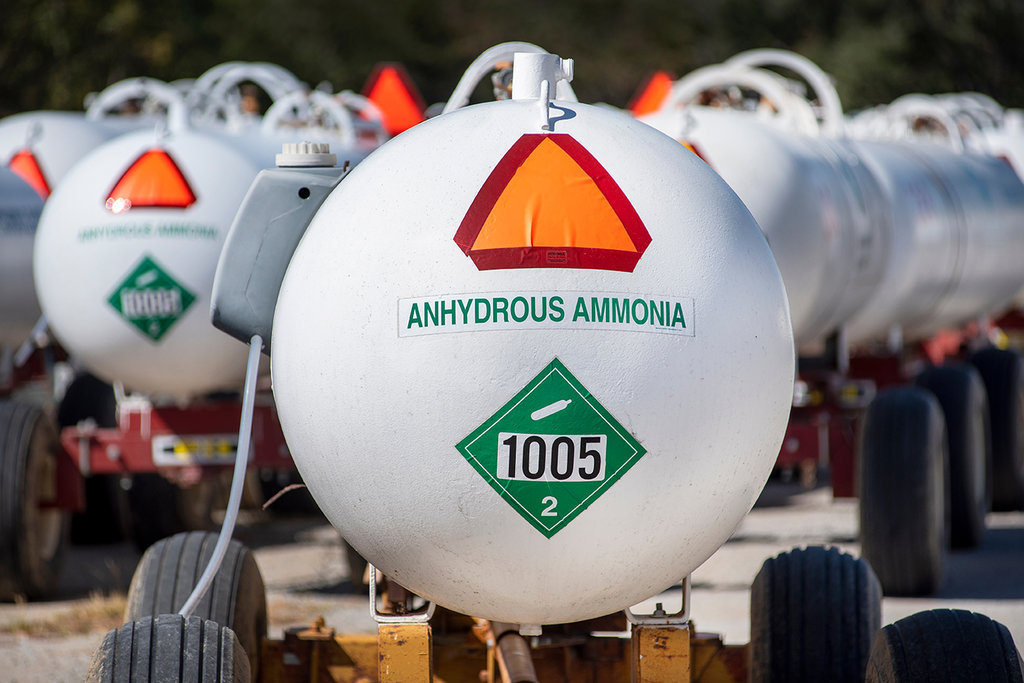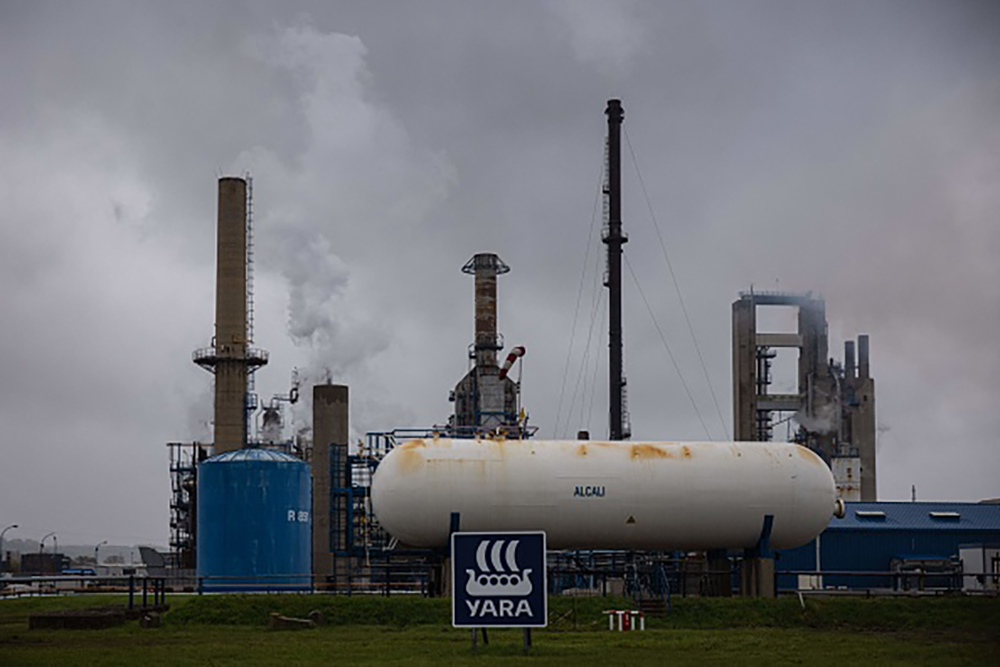Cover story
Cleaning fluid, cleaner power: Can clean ammonia move into energy generation?
An existing chemical industry might have part of the answer to our power generation challenge. Andrew Tunnicliffe speaks with Yara Clean Ammonia president, Magnus Ankarstrand.

Ammonia in use as a fertiliser. Credit: Charles Brutlag
Since its discovery by philosopher and scientist Henry Cavendish more than 250 years ago, hydrogen and its many uses have come a long way. Arguably that journey can be summarised by the colour it takes, ranging from its first incarnation of brown through grey, blue and green. Cavendish was a visionary in the mid-to-late 1700s, also experimenting with “fixed air”, or what we now know to be carbon dioxide (CO₂).
The difference between brown, grey and blue hydrogen, and the colour of the moment green, is the energy source used to create it. Green is renewable, whilst the others are derived from fossil fuels. Regardless of how the element is produced, when burned it emits no pollutants or greenhouse gasses, only water vapour. It is, therefore, an energy source that offers great potential in the transition to net zero emissions.
There are, though, some problems. Its transportation infrastructure is underdeveloped, and some have raised concerns that green hydrogen production saps renewable energy sources from national power grids. Hydrogen itself possesses a low energy content by volume, making it difficult to store as it requires high pressure and low temperatures through cryogenic tanks or high-pressure cylinders.
Is ammonia fertile ground for power generation?
One solution might be ammonia. In recent months there has been growing interest in the chemical and its potential to be the fuel of the future and a part solution to the climate crisis. Magnus Ankarstrand, president of Yara Clean Ammonia – a subsidiary of Norway-based chemicals manufacturer Yara – is a little more pragmatic on the issue: “I think it's one of many fuels.
“There are others that we know of today – methanol and hydrogen – and probably others to come that we don’t yet know about. But it's CO₂-free and contains 50% more energy than hydrogen.” Other benefits include a storage temperature of -33°C, compared to hydrogen at -250°C, and a higher energy content for its volume, reducing the size of storage tanks.
A report suggests that in 2022, the world produced almost 195 million metric tonnes of commercial ammonia, adding that production will rise to more than 218 million metric tonnes by the end of 2028. The chemical is used in industries such as textiles, mining, pharmaceutical and refrigeration. However, according to the research association American Chemical Society, agriculture accounted for as much as 85% of usage in 2021. The chemical is widely used to create fertiliser, and as such a well-developed distribution chain already exists.
Green hydrogen, clean ammonia
The long-standing issue with ammonia production is its impact on the climate. Hydrogen, critical to the to the process, is produced by steam methane reforming (SMR), a method developed in 1909. This brings together air-sourced nitrogen and hydrogen at high pressure and temperatures of around 400–600°C. It is then run over a catalyst bed to produce ammonia.
However, that process creates “quite a lot of CO₂” says Ankarstrand, an issue that Yara is working to address. Around 90% of the CO₂ produced comes directly from the SMR process according to UK research institute The Royal Society. In a February 2020 briefing on green ammonia, the Society said: “This process [SMR] consumes a lot of energy and produces around 1.8% of global carbon dioxide emissions.”

Agricultural ammonia tankers. Credit: Jon Rehg via Shutterstock
The solution might be clean ammonia, either green or blue, produced solely by renewables or using fossil fuels with carbon capture, respectively. Ankarstrand says Yara is looking at different ways of removing or reducing CO₂ from the production process, including using electrolysis. This is a proposition the Royal Society spoke of in its briefing: “One way of making green ammonia is by using hydrogen from water electrolysis and nitrogen separated from the air. These are then fed into the Haber process [for ammonia generation], all powered by sustainable electricity.”
Chemical manufacturers moving into energy
Yara, like other chemical manufactures, wants to support the use of clean ammonia in food production, shipping and power generation. Hopes of using it to fuel power plants and ship engines have long been held. Ankarstrand explains: “Today it's [ammonia] essentially used as a fertiliser, or in chemicals production. But when we use it to produce nitrate fertiliser, we first make nitric acid by burning the ammonia with oxygen. That process releases a massive amount of energy as steam.” He says powering engines or power plants this way is not dissimilar to how they are already powered – burning ammonia generates steam.
This, he says, in theory means ammonia could replace coal at power plants, producing enough energy to operate turbines. “The physics are relatively straightforward,” he says. “But to create an efficient and reliable production process, that's a different matter.”
Ankarstrand remains optimistic about the prospect of ammonia-burning engines entering the market in the next year or so; however, there is further work to be done in power generation. “That technology needs to be developed. The basic knowledge is there, but it needs to be fine-tuned and tested.” Pilot projects should be coming on stream in around three years, he adds.
Powering partnerships
In 2021, Yara announced it had secured a memorandum of understanding (MoU) with Japan’s fuel and renewable power generator JERA, a major importer of fuels such as coal and LNG. Around that time, Japan set its sights on the use of ammonia in power generation and shipping. The Ministry for Economy, Trade and Industry of the world’s fifth biggest CO₂ emitter said by the end of the decade it expected to import 3 million tonnes of clean ammonia under its Green Growth Strategy, rising to 30 million by 2050.
Under the MoU Yara would supply clean ammonia and support the development of technologies to burn it at scale. The partnership would help the industry and country establish supply chains and the logistical infrastructure needed to deliver on the ambitious target to add ammonia to the fuel mix and reach net zero emissions by 2050. At the beginning of this year, the two signed a second MoU under which Yara will supply up to 500 kilotons of clean ammonia to the Hekinan Thermal Power Plant Unit 4 in Hekinan, and partner on blue ammonia production in the US Gulf.

A Yara ammonia plant in Le Havre, western France. Credit: Sameer Al-Doumy/AFP via Getty Images
Yara is not alone in developing technologies, supply chains, and projects to produce and supply clean ammonia for power generation. Other major players include US industrial gas and chemical business Air Products, which in 2020 embarked on $5bn joint investment on a chemical production plant powered by 4GW of renewable energy in Saudi Arabia. India’s ACME Group, is also working on a green hydrogen and ammonia project, in Oman, and Mitsubishi Heavy Industries has been working on 100% ammonia-capable turbines over the past couple of years.
“The LNG of hydrogen”
Ankarstrand believes collaborations like that of Yara and JERA are crucial, particularly in the near-to-mid-term. “If you're a shipowner or power generator and you want to make major investments all in equipment, engines, vessels, whatever runs on ammonia and zero carbon fuel, you want to know that those fuels will be available,” he says. But he believes the presence of the existing market and mature distribution network is a major benefit; and, he says, ammonia has the potential to become “the LNG of hydrogen” – although that goal remains some way off.
With the push to decarbonise and major investment in clean ammonia, it seems the market has a promising future. Carbon capture and storage, green production through renewable power and major investments in production all position it to be among the most effective solutions in coming years. As power generators and their supply chains continue to innovate, and the transportation and logistics markets look for increasingly green solutions, headlines like “Can clean ammonia move into energy generation?” may be answered.
For Ankarstrand, the next piece of the puzzle has to come form lawmakers. Asked if he thought they were doing enough to support the market’s development, his view was clear: “No.” He adds that there is a need for “uniform, universal and clear regulation” rather than the “bespoke project support” seen thus far. There also needs to be positive incentives, such as the Inflation Reduction Act in the US, which “is a very good step forward”. For now, in Europe, there is “more stick and no carrot”. It seems the market is doing what it can, and attention turns to politicians and the need to innovate.